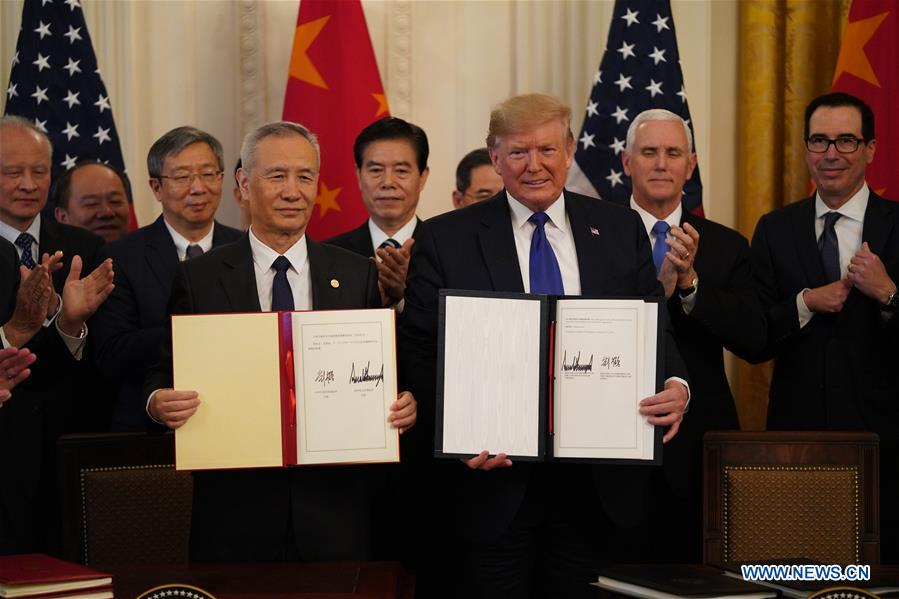
An empty street in Washington D.C., the United States, May 6, 2020. /Xinhua
**Editor's note: **Iram Khan is a Pakistan-based commentator on international and commercial affairs. The article reflects the author's opinions, and not necessarily the views of CGTN.
In yet another attempt at making the upcoming U.S. presidential election China-centric, the Trump administration has revealed plans to "turbo-charge" the removal of global and industrial supply chains away from China.
But the interdependence of both countries' manufacturing sectors, international logistic channels, and prevailing circumstances manifest that this is going to be next to impossible.
The capital-intensive task is not likely to materialize for various reasons.
The foremost is that production in the U.S. today is far more expensive than what it was before China took over as the world's manufacturing powerhouse. Skyrocketing wages and a soaring dollar have since then taken away the competitive advantage from U.S.-made goods.
American brands are thriving today because they are either entirely producing in China or are getting most of their parts made there. If they shift their assembly lines back to the U.S., they will immediately collapse after factoring in the price handicap.
China has lately been focusing on high-quality national development which has resulted in the promotion of high-quality technologies. Gone are the days when the country was only associated with making toys, T-shirts and tennis shoes. Aircrafts, new energy vehicles, sophisticated computing systems and 5G are fast maturing and raking in top-notch companies and clients. Unplugging from such a cutting edge investment landscape is simply impractical for the stakeholders.
The previous economic assault of the U.S. had led to a manufacturing recession for American firms that lingered well into 2020. The tariff-induced trade war, as it is remembered, was disastrous for the U.S. aluminum, automotive, electronics and agricultural industries. When it reached its peak, the Oval Office was scrambling for a trade deal.
Donald Trump's fixation with signing deals comes at the cost of the economic crises that precede them. In addition to boasting the phase-one deal with China as a feather in his cap, he perhaps plans another one ahead of the November election by making the supply chain-focused ploy a priority.
But with the prevailing economic uncertainty, neither a deal is possible nor is the materialization of an attractive package for U.S. companies. A vaccine is projected to be approved around next year and any misadventure before that will reduce the already slim chances of Trump's re-election.

U.S. President Donald Trump and Chinese Vice Premier Liu He show the signed China-U.S. phase-one economic and trade agreement during a ceremony at the East Room of the White House in Washington D.C., the United States, January 15, 2020. /Xinhua
Trump's foreign allies are also not expected to lend support since they know it is a part of his domestic political strategy and an attempt to cover up his deplorable response to the COVID-19 outbreak. Some of them have actually held the U.S. responsible for the spread of the virus in their countries. And when he engaged in modern-day piracy by confiscating protective equipment purchased by other countries, he was accused of mistreating his transatlantic partners.
Even before the epidemic, Trump's hyper-nationalistic policy of "America First" was morphing into "America Only." He withdrew from obligations to international bodies and took unilateral decisions with disastrous impacts, angering his European allies who in turn refused to endorse his so-called crackdown against Chinese companies.
The ongoing COVID-19 pandemic has caused a severe financial crunch in the U.S. Buying power of consumers has tanked as unemployment has reached record high.
Under these conditions, it is not perceivable for businesses to move to the U.S., make expensive products, and expect the buyers to prefer them. In the globalized economy, it is the market forces – not politics – that determine the realistic supply and demand for goods and services.
Then there is the issue of the lack of skilled human resources to man the factories if they are forced to move to the U.S. or elsewhere.
Supply chains leverage specialized capabilities of industries in various parts of the world and integrate them to form an efficient and cost-effective network. These geographically displaced specializations have matured to a level that disrupting them will cost economically unfeasible time and effort.
And will it be feasible for the Trump administration to raise trained manpower matching China's prowess? Both countries are accelerating the implementation of industrial internet and the employment of machines at assembly lines. So the monumental training exercise, if taken up, will become outdated even before bearing any results.
White House advisers must understand that the rhetoric against China is not connected with reality. China and its partners can handle setbacks due to the robust supply chain network offered by the Belt and Road Initiative. But the U.S., in the absence of a viable alternative, will find itself further isolated and losing out in the needless competition.
(If you want to contribute and have specific expertise, please contact us at [email protected].)
 简体中文
简体中文

